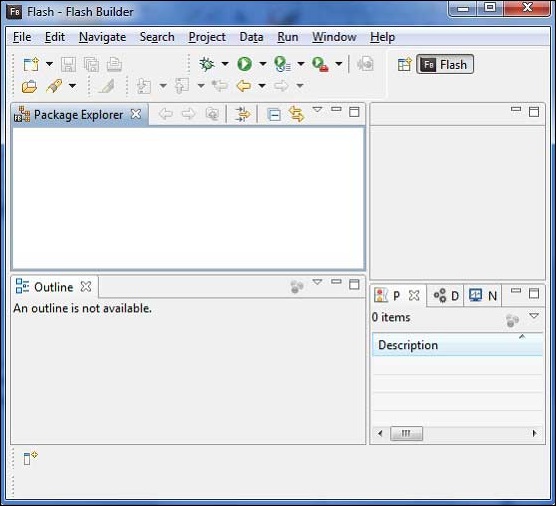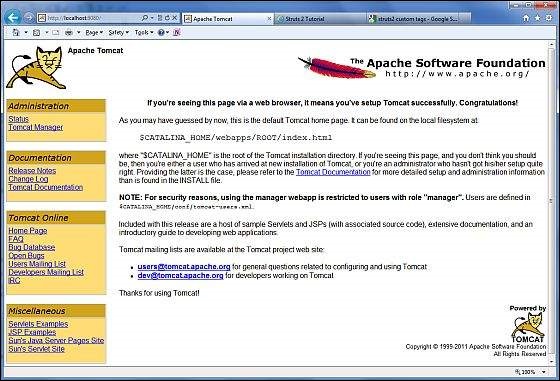This tutorial will guide you on how to prepare a development
environment to start your work with Adobe Flex Framework. This tutorial
will also teach you how to setup JDK and Adobe Flash Builder on your
machine before you setup Flex Framework:
Follow the given steps to setup your environment to start with Flex application development.
Let's verify the output for all the operating systems:
Set the JAVA_HOME environment variable to point to the base directory location where Java is installed on your machine. For example
Append Java compiler location to System Path.
To install Adobe Flash Builder IDE, download the latest Adobe Flash Builder binaries from http://www.adobe.com/in/products/flash-builder.html. Once you downloaded the installation, unpack the binary distribution into a convenient location. For example in C:\flash-builder on windows, or /usr/local/flash-builder on Linux/Unix and finally set PATH variable appropriately.
Flash Builder can be started by executing the following commands on windows machine, or you can simply double click on FlashBuilder.exe
After a successful startup, if everything is fine then it should display following result:
 Adobe Flash Builder comes pre-configured with FLEX SDKs. We're using
FLEX SDK 4.5 in our examples which comes bundled with Adobe Flash
Builder 4.5.
Adobe Flash Builder comes pre-configured with FLEX SDKs. We're using
FLEX SDK 4.5 in our examples which comes bundled with Adobe Flash
Builder 4.5.
Tomcat can be started by executing the following commands on windows machine, or you can simply double click on startup.bat
 Further information about configuring and running Tomcat can be found
in the documentation included here, as well as on the Tomcat web site:
http://tomcat.apache.org
Further information about configuring and running Tomcat can be found
in the documentation included here, as well as on the Tomcat web site:
http://tomcat.apache.org
Tomcat can be stopped by executing the following commands on windows machine:
System Requirement
FLEX requires JDK 1.4 or higher so the very first requirement is to have JDK installed in your machine.| JDK | 1.4 or above. |
|---|---|
| Memory | no minimum requirement. |
| Disk Space | no minimum requirement. |
| Operating System | no minimum requirement. |
Step 1 - Verify Java installation on your machine
Now open console and execute the following java command.| OS | Task | Command |
|---|---|---|
| Windows | Open Command Console | c:\> java -version |
| Linux | Open Command Terminal | $ java -version |
| Mac | Open Terminal | machine:~ joseph$ java -version |
| OS | Generated Output |
|---|---|
| Windows |
java version "1.6.0_21" Java(TM) SE Runtime Environment (build 1.6.0_21-b07) Java HotSpot(TM) Client VM (build 17.0-b17, mixed mode, sharing) |
| Linux |
java version "1.6.0_21" Java(TM) SE Runtime Environment (build 1.6.0_21-b07) Java HotSpot(TM) Client VM (build 17.0-b17, mixed mode, sharing) |
| Mac |
java version "1.6.0_21" Java(TM) SE Runtime Environment (build 1.6.0_21-b07) Java HotSpot(TM)64-Bit Server VM (build 17.0-b17, mixed mode, sharing) |
Step 2 - Setup Java Development Kit (JDK):
If you do not have Java installed then you can install the Java Software Development Kit (SDK) from Oracle's Java site: Java SE Downloads. You will find instructions for installing JDK in downloaded files, follow the given instructions to install and configure the setup. Finally set PATH and JAVA_HOME environment variables to refer to the directory that contains java and javac, typically java_install_dir/bin and java_install_dir respectively.Set the JAVA_HOME environment variable to point to the base directory location where Java is installed on your machine. For example
| OS | Output |
|---|---|
| Windows | Set the environment variable JAVA_HOME to C:\Program Files\Java\jdk1.6.0_21 |
| Linux | export JAVA_HOME=/usr/local/java-current |
| Mac | export JAVA_HOME=/Library/Java/Home |
| OS | Output |
|---|---|
| Windows | Append the string ;%JAVA_HOME%\bin to the end of the system variable, Path. |
| Linux | export PATH=$PATH:$JAVA_HOME/bin/ |
| Mac | not required |
Step 3 - Setup Adobe Flash Builder 4.5
All the examples in this tutorial have been written using Adobe Flash Builder 4.5 Profession IDE Trial Version. So I would suggest you should have latest version of Adobe Flash Builder installed on your machine based on your operating system.To install Adobe Flash Builder IDE, download the latest Adobe Flash Builder binaries from http://www.adobe.com/in/products/flash-builder.html. Once you downloaded the installation, unpack the binary distribution into a convenient location. For example in C:\flash-builder on windows, or /usr/local/flash-builder on Linux/Unix and finally set PATH variable appropriately.
Flash Builder can be started by executing the following commands on windows machine, or you can simply double click on FlashBuilder.exe
%C:\flash-builder\FlashBuilder.exeFlash Builder can be started by executing the following commands on Unix (Solaris, Linux, etc.) machine:
$/usr/local/flash-builder/FlashBuilderAdobe Flash Builder Trial Version can be used for 60 days. Just accept the terms and conditions and skip the initial registration steps and continue with the IDE. We're using the trial version for teaching purpose.
After a successful startup, if everything is fine then it should display following result:
 Adobe Flash Builder comes pre-configured with FLEX SDKs. We're using
FLEX SDK 4.5 in our examples which comes bundled with Adobe Flash
Builder 4.5.
Adobe Flash Builder comes pre-configured with FLEX SDKs. We're using
FLEX SDK 4.5 in our examples which comes bundled with Adobe Flash
Builder 4.5.Step 4: Setup Apache Tomcat:
You can download the latest version of Tomcat from http://tomcat.apache.org/. Once you downloaded the installation, unpack the binary distribution into a convenient location. For example in C:\apache-tomcat-6.0.33 on windows, or /usr/local/apache-tomcat-6.0.33 on Linux/Unix and set CATALINA_HOME environment variable pointing to the installation locations.Tomcat can be started by executing the following commands on windows machine, or you can simply double click on startup.bat
%CATALINA_HOME%\bin\startup.bat or C:\apache-tomcat-6.0.33\bin\startup.batTomcat can be started by executing the following commands on Unix (Solaris, Linux, etc.) machine:
$CATALINA_HOME/bin/startup.sh or /usr/local/apache-tomcat-6.0.33/bin/startup.shAfter a successful startup, the default web applications included with Tomcat will be available by visiting http://localhost:8080/. If everything is fine then it should display following result:
 Further information about configuring and running Tomcat can be found
in the documentation included here, as well as on the Tomcat web site:
http://tomcat.apache.org
Further information about configuring and running Tomcat can be found
in the documentation included here, as well as on the Tomcat web site:
http://tomcat.apache.orgTomcat can be stopped by executing the following commands on windows machine:
%CATALINA_HOME%\bin\shutdown or C:\apache-tomcat-5.5.29\bin\shutdownTomcat can be stopped by executing the following commands on Unix (Solaris, Linux, etc.) machine:
$CATALINA_HOME/bin/shutdown.sh or /usr/local/apache-tomcat-5.5.29/bin/shutdown.sh

No comments:
Post a Comment